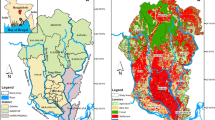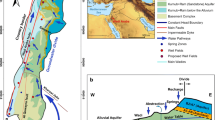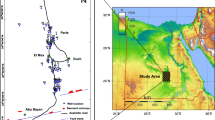Abstract
Fossil groundwater is used for water supply and irrigation in some arid regions where the replenishment of groundwater by precipitation is low. Numerical modelling is a helpful tool in the assessment of groundwater resources and analysis of future exploitation scenarios. To quantify the groundwater resources of the Dakhla area in the southern Sahara, Morocco, the present study assesses the groundwater resources management of the Paleogene aquifer. Groundwater withdrawals have increased in this area, resulting in a disturbance of the aquifer’s natural equilibrium, and the large-scale and ongoing depletion of this critical water reserve. Negative impacts, such as a decline in water levels, have been experienced. The methodology includes application of numerical groundwater modelling in steady and transient states under different measures and abstraction scenarios. The numerical simulation model developed was applied to assess the responses of the Paleogene aquifer water level under different pumping scenarios during the next 10 years. Groundwater management scenarios are evaluated to find an optimal management solution to satisfy future needs. To cope with the unfavourable state of the water resources of Dakhla in the coming years, a groundwater contract was developed to save the groundwater resources and not compromise the socio-economic development of the region, particularly agricultural development. This contract includes technical, organizational and financial measures. They were discussed in workshops with all stakeholders to identify good management alternatives in the Dakhla area in south of Morocco.
Access provided by CONRICYT-eBooks. Download conference paper PDF
Similar content being viewed by others
Keywords
1 Introduction
Approximately one-third of the world’s land area is arid or semi-arid. These regions face major challenges in the management of scarce freshwater resources under the pressures of population and the global change. Groundwater maybe the only source of water supply in such regions, and so needs water balance quantification to manage its limited resources. This study presents a groundwater flow model to assess optimal pumping rate under an expected increase in irrigation water requirements.
The Dakhla area, in the southern of the Morocco’s Sahara, was selected in this study of groundwater resource quantification due to the fast growing need for utilization of non-renewable groundwater resources (Edoulati et al., 2013). Groundwater is mainly used for irrigation, domestic, and small industrial purposes. Under present climatic conditions, the rate of groundwater recharge is very low, so the groundwater resources will be exhausted in the near future if abstraction continues with present trends. Due to the increase in population and expansion of the irrigated area, groundwater management is under environmental constraints. Determining the availability of groundwater resources in the Dakhla area is done using a simulation model in order to meet present and future water demands, and also to understand the physical behaviour of the Paleogene aquifer system in southern Morocco (Fig. 1). The Dakhla area lies within the Sahara in southern Morocco which is characterized by an arid climate zone; the aridity index is 0.9 (index De Martonne 1926).
This work describes the history of groundwater pumping from the Paleogene aquifer, the hydrogeological setting, the resulting negative impacts on groundwater levels and the various stages involved in the development of a three-dimensional (3D) simulation model of the interactive aquifer system followed by a prediction stage to evaluate the effects of long-term pumping on groundwater in the study area. Due to socio-economic growth over the last decade and due to consolidation of wells in Dakhla Bay, severe environmental problems have increased, with a steady decline in the piezometric surface area.
2 Objectives
The objective of this study is to find an optimal management solution to satisfy future water needs. This will be achieved through numerical groundwater flow modelling. The model results document a method to quantify the sustainable yield of a groundwater flow system. The transient calibration was used to simulate potential future water use scenarios, to guide the technical, regulatory and financial measures that constitute the contract of the Dakhla groundwater.
Note that there is no valuable predicted precipitation until 2025 that could be included in the scenarios.
3 Hydrogeological Background
The Paleogene aquifer is part of the Aaiun sedimentary basin (Labails and Olivet, 2009) in the Moroccan Sahara and attains a thickness of more than 250 m. It is represented by the formation of Puerto Rico (Rjimati and Zemmouri, 2002). The Dakhla area is located in the hyperarid region of Sahara. The groundwater resources of the study area flowing into a complex aquifer, which consists on (from bottom to top): a Lower Cretaceous formation contains a deep aquifer flowing into deposits of white sands and red sandy clays, a Paleogene formation containing a deep aquifer flowing in sandstones and sands, and a formation of Pliocene-Quaternary containing confined aquifer. The deep groundwater of the study area is fossil water and is non-renewable, confirmed by National Energy Center of Sciences and Nuclear Techniques (CNESTEN). More than 60 production wells were drilled within the area and the salinity varies between 1.8 and 2.8 g/l (Hydraulic Basin Agency). The area of Dakhla Bay exploited and explored by the electrical geophysical method (VES) were defined as a prerequisite to representing the geometric framework of the groundwater flow modelling.
The substratum characterized by marl is encountered at various depths ranging from +40 to −720 m relative to the mean sea level reference. The saturated thickness of the aquifer is highly variable ranging between 10 and 250 m. The lower boundary of the aquifer system is represented by the semipermeable sandy marl. The roof and the substratum of the aquifer of Paleogene shows a general decreases from East to West and North, and South to the North, except for a slightly lower area at Gleib Jediane in the center of the study area. The eastern boundary is represented by a discontinuity D1 representing the outcrop of the aquifer roof. The western boundary of the aquifer is unclear, because the formation continues under the sea (Fig. 2a).
a Three-dimensional (3D) simulation model of aquifer of Paleogene, b head distribution of the pre-development calibrated steady simulation flow model 2005, c total head distribution of the calibrated transient flow model 2015, and d, e calculated versus observed head corresponds respectively to steady simulation flow model 2005 and transient flow model 2015
Consequently, the Dakhla Bay may have a considerable reserve of groundwater. All the wells in the study area are artesian (Fig. 1b); for instance the pressure at the well head no. 19 can reach 6.8 bars (Fig. 1b). Owing to low abstraction rates prior to 2005, the static water-level contour is considered to represent the steady-state conditions of the aquifer. The aquifer system is recharged from the east part of the study area, and naturally discharges to the west. Water-level monitoring from 1984 until 2015 was carried out in several observation boreholes.
Measurements in most of the boreholes record a decline of water level with time; evidently the heavy pumping of the aquifer has caused significant drawdown. The abstraction rate was relatively low until 2005; since then it has increased tremendously, which seemingly corresponds to the progressive population increase and the multiplication of agricultural projects.
The average increase of depth to water, measured from ground elevation, is about 15 m over the last 10 years, showing that the water level declined by 1.5 m year−1. Evidently, the former remarkable decline of water level is due to the drilling of more than 60 production wells within the study area.
4 Results
4.1 Steady-State Conditions in 2005
The calculated boundary inflow and outflow in 2005 were estimated as 1.9 × 104 m3 d−1. The water budget from the numerical model lies within the tolerable range of the previously estimated total budget. After calibration of the boundary conditions, the reducing head variance was adjusted by modification of the hydraulic conductivity distribution. The hydraulic conductivity has been divided into five zones and varied between 1.6 × 10−5 and 1 × 10−5 m s−1, which are consistent with values calculated from pumping tests on wells in the study area, electric fields, and geological facies present.
For the inverse leakance field and after several simulations, the values are divided into five areas according to the geology, and the thickness of the layer aquitard, these values varied between 3.7 × 10−11 and 5.7 × 10−11 m s−1. The total head varies between 30 and 90 m, while the RMS error is 5 m. It is evident that the total head of groundwater in the study area correlated well with the initial heads of 2005 (Fig. 2b).
4.2 Transient Conditions
Based on the pattern of the aquifer parameters obtained during steady-state calibration, the model was subjected to transient calibration for a period of 10 years between 2005 and 2015; the mean records hydraulic head to 2005, 2011 and 2015 are meanly valuable information used for model calibration, in addition to irregular information in time of some observation wells. During each stress period (year) all external stresses and boundary conditions were kept constant. The transient run was simulated from the calibrated steady flow model; the only modification is that of the quantity in flows through the eastern boundary, the flow imposed will therefore be 8500 m3 d−1 as a calibrated value. The simulated piezometric levels at 2015 are shown in (Fig. 2c). On the calibrated transient model, the value of the homogeneous Specific Storage of 1 × 10−5 m−1 was adjusted by the values Ss1 = 5 × 10−5 m−1; Ss2 = 6 × 10−5 m−1 and Ss3 = 8 × 10−6 m−1 the mean value are for different areas.
As for steady-state calibration, it is necessary to carry out transient-mode sensitivity tests. In this case, the analysis was carried out with respect to the storage coefficient and the recharge by inverse drainage. The results obtained by these sensitivity tests show that the model is always sensitive to recharge. The model verification was carried out with the final run of the transient calibration stage at the end of 2015; a scatterplot compares the simulated and observed.
5 Discussion
5.1 Model Predictions and Aquifer Potential
Unfortunately, human activities, such as groundwater extraction for irrigation, have resulted in excessive groundwater level declines and aquifer overdraft. A successfully calibrated and verified simulation model can be used for formulating various different water development schemes. The schemes can be compared in terms of their feasibility for efficient utilization of the available groundwater resources. The selected development schemes must, when implemented, meet the future water demand at a minimum cost commensurate with legal, organizational, political and environmental considerations. Three scenarios were considered to predict the consequences of future development in the model area. A planning period of 10 years (2015–2025) was used for the three scenarios, related to of a draft groundwater contract, the aim of which is to rationalize the exploitation of this water table, in a framework of consultation involving all the parties concerned. The starting conditions in each scenario were those obtained from the transient simulation at the end of 2015. These three scenarios are as follows:
-
Scenario I The first scenario assumes that the groundwater abstraction observed during 2015 continues without modification. The destocking of the Paleogene GW would be 13.8 Mm3 in 2025 (Fig. 3a).
-
Scenario II Maintenance of current agricultural levies and simulation of future drinking water needs, with the commissioning of the purified wastewater treatment plant (WWTP). The destocking of the Paleogene GW would be 14.7 Mm3 in 2025 (Fig. 3b).
-
Scenario III Increase in agricultural levies for irrigation of 150 ha per year up to 2022 and simulation of future drinking water requirements, The destocking of the Paleogene GW would be 20.7 Mm3 in 2025 (Fig. 3c).
Scenarios I and II show a cone of depression with a maximum drawdown of about 10 m, the use of wastewater would reduce the impact of future drinking water requirements. The option of the Green Morocco Plan’s strategy (www.agriculture.gov.ma) assumes an increase in cultivated areas of more than 200% (2000 acres), the model prediction shows the maximum drawdown in collecting drinking water area and the agricultural area, would be about 20 m for scenario III.
5.2 Groundwater Contract
Based on scenario III, a Dakhla groundwater contract is signed by the stakeholders to safeguard the groundwater and to develop the socio-economic activities of the region. The partners have agreed to respect the following principles which aim to safeguard the groundwater: extensions of agricultural areas will benefit primarily social and solidary agriculture; Use desalination of seawater to meet future water requirements; Irrigate green areas from treated wastewater; The increase in the rate of the irrigation levy should not concern small farmers; Focus future agricultural projects outside Dakhla Bay; Sharing of data; Sensitization of users.
The technical measures focus on: study of an alternative groundwater “Lagçayba”; Mobilization of surface water; Protection against floods; Control of volumes taken; Control of water abstraction; Water economy in irrigation; Monitoring system for control of the groundwater; Mobilization of non-conventional resources; Management of boreholes for irrigation of green areas; Delimitation of the hydraulic public domain. Organizational measures consist of the creation of two structures: the Dakhla groundwater committee which is responsible for ensuring the implementation of the various operations of the action plan and the accompanying measures and the monitoring committee Responsible for monitoring and implementing all operational programs. The financial measures concern the commitment to mobilize the financial resources to carry out the operations programmed in the contract of the deep Aquifer of Dakhla Bay.
6 Conclusion
Numerical groundwater modelling is a powerful tool for assessment, development and management of groundwater resources. A numerical groundwater model for the Dakhla arid area in Morocco was developed using the MODFLOW code to simulate local groundwater changes in the Paleogene aquifer under transient conditions.
Hydrogeological data from different sources and previous studies were integrated in the model. Initially a conceptual model was developed comprising identification of hydrogeological units, parameterization of these units, identification of the system boundaries and identification of the water budget components. These were transferred into the mathematical groundwater model. All available measurements of water level, well discharges and hydraulic parameters were used for model calibration. The model was optimized through improved definition of the boundary conditions and other relevant parameters, such as well discharges. When the model calibration and validation were complete, different groundwater management scenarios were evaluated to find an optimal management solution to satisfy future needs. Three different development schemes were assessed to test the Paleogene aquifer under long-term water pumping stresses. Scenario III, with a gradual increase in pumping for agricultural purposes over the next 10 years at 150 ha/year is selected after extensive consultation with all stakeholders in the water sector in the Dakhla region. A groundwater contract between all stakeholders was developed to save the underground resources and not compromise the socio-economic development of the region, particularly agricultural development. This contract, includes technical, organizational and financial measures, is concerted with all the stakeholders in order to govern the Paleogene water resources at the Dakhla Bay in southern of Morocco.
References
Edoulati N, Boutaleb S, Bettar I, Ouchbani A (2013) Contributions of chemical and isotopic tools for understanding the groundwater modes recharge and flow in the lower cretaceous aquifer in the Moroccan Sahara. J Water Resour Prot 5:183–199
Labails C, Olivet J-L (2009) Crustal structure of the SW Moroccan margin from wide-angle and reflection seismic data (the Dakhla experiment). Part B—The tectonic heritage. Tectonophysics 468(1–4):83–97. doi:10.1016/j.tecto.2008.08.028
Rjimati E, Zemmouri A (2002) Geological map of Morocco at 1/100 000.Ad-Dakhla sheet, NF-28-XI-3. Notes Mem Geol Serv no 438bis. ISSN 0374-9789
Acknowledgements
The authors thank the members of the Hydraulic Basin Agency Sakia El Hamra and Oued Ed-Dahab, for their collaboration and for the documents that they make available to us.
Author information
Authors and Affiliations
Corresponding author
Editor information
Editors and Affiliations
Rights and permissions
Copyright information
© 2018 Springer International Publishing AG
About this paper
Cite this paper
El Kanti, S.M., El Mansouri, B., Arjdal, Y., Larabi, A. (2018). Numerical Groundwater Modelling as an Effective Tool for Management of the Deep Aquifer at the Dakhla Bay (South of Morocco). In: Calvache, M., Duque, C., Pulido-Velazquez, D. (eds) Groundwater and Global Change in the Western Mediterranean Area. Environmental Earth Sciences. Springer, Cham. https://doi.org/10.1007/978-3-319-69356-9_15
Download citation
DOI: https://doi.org/10.1007/978-3-319-69356-9_15
Published:
Publisher Name: Springer, Cham
Print ISBN: 978-3-319-69355-2
Online ISBN: 978-3-319-69356-9
eBook Packages: Earth and Environmental ScienceEarth and Environmental Science (R0)







